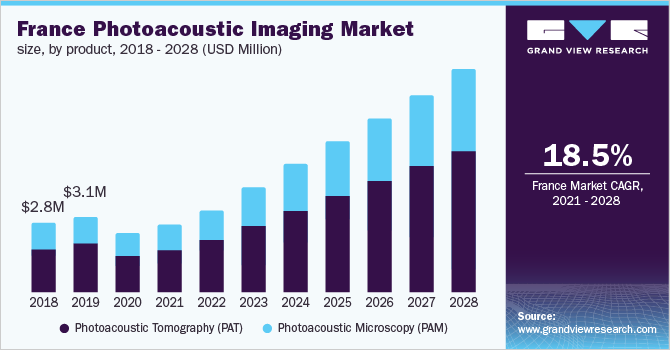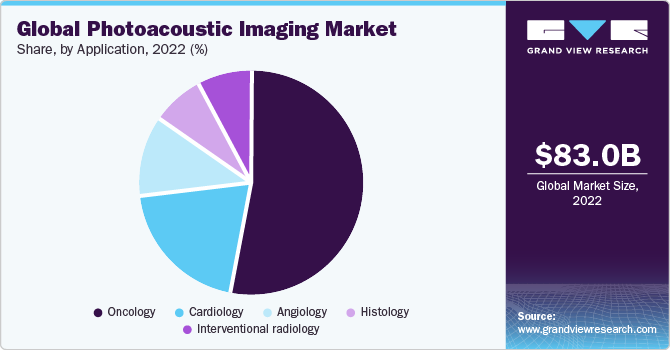
Photoacoustic Imaging Market Size, Share & Trends Analysis Report By Product (PAT, PAM), By Type (Pre-clinical, Clinical), By Application (Oncology, Cardiology, Angiology), By Region, And Segment Forecasts, 2021 - 2028
- Report ID: GVR-4-68039-804-2
- Number of Pages: 120
- Format: Electronic (PDF)
- Historical Range: 2016 - 2019
- Industry:Healthcare
Report Overview
The global photoacoustic imaging market size was valued at USD 61.6 million in 2020 and is anticipated to grow at a compound annual growth rate (CAGR) of 19% over the forecast period. The increasing incidence of cancer, primarily breast cancer, and rising research studies in the fields of non-ionizing radiation for imaging are boosting the market growth. For instance, according to the WHO, in 2020, there were about 2.3 million women diagnosed with breast cancer and 685,000 deaths worldwide. In addition, the growing scope of applications is equally contributing to the market expansion. Photoacoustic Imaging (PAI) is superior to other diagnostic imaging systems as it uses non-ionizing radiation to examine tissues in real-time with high resolution and contrast, at long penetration depths, and allowing morphological, functional, and molecular imaging of living subjects.

Also, it has faster imaging speed and sensitivity, as well as better handling and diagnostic accuracy. One of the major advantages of PAI is that it can be simply implemented on clinical ultrasound machines, allowing cellular and molecular imaging to be added to the spectrum of traditional ultrasound imaging. However, constraints, such as the high cost of these systems, limited bandwidth causing an inability to detect signals outside of the sensor's frequency range, acquisition time, and the limitations set by ANSI laser safety regulations, may hinder the market growth over the projected period.
The growing application in research and development activities is expected to increase product demand over the forecast period. Many researchers have recently concentrated their efforts on studying deep tissues to utilize PAI in clinical diagnosis and treatment. For instance, Prof. Chulhong Kim of Creative IT Engineering from POSTECH and his students presented a new contrast agent for deep tissue PAI. As a contrast agent, they used a nickel-based nanoparticle that absorbs light at a wavelength of 1,064 nm. In comparison to previous studies, they obtained images of tissues penetrated to a maximum depth of 3.4 cm in live animals, which is the deepest image obtained using this wavelength.
Photoacoustic imaging has been extensively used in preclinical studies, particularly on cancer models, and has allowed for a reduction in the number of animals sacrificed over time. The healthcare system had faced enormous difficulties as a result of the COVID-19 pandemic. The global healthcare supply chain had been impacted by the pandemic. Shortages of raw materials resulted in a drop in imaging device manufacturing, as well as disruptions in transportation, creating widespread business disruption. However, the market is gradually growing gas lockdown restrictions have been lifted across the globe.
Product Insights
The Photoacoustic Tomography (PAT) segment dominated the market with the largest revenue share of 63.5% in 2020. The segment is expected to continue its dominance over the forecast period. PAT is the most generic and least restrictive photoacoustic imaging technique, with the fewest practical limits on imaging performance. The PAT technique has been rapidly advancing in terms of spatial resolution, frame rates, and detection sensitivity. PAT’s uses in basic biological sciences have substantially grown, and several clinical applications have been proposed. Furthermore, with its unique combination of optical absorption contrast and ultrasonic imaging depth and resolution scalability, PAT is expected to have more efficient applications in biomedical research and clinical practice.
光声显微术(PAM),它提供了安娜tomical, functional, and molecular information, has become a more common biomedical technique. PAM, unlike pure optical microscopic methods, takes advantage of tissue’s weak acoustic scattering to overcome the optical diffusion limit. PAM’s scalability allows it to produce high-resolution images at specified maximum imaging depths of a few millimeters. Even though PAM currently has been commercialized for preclinical applications, the future commercialization of clinical applications will significantly accelerate PAM’s translation from laboratory technology to mainstream imaging modality.
Application Insights
The oncology segment dominated the market with the largest revenue share of 53% in 2020 and is expected to continue its dominance over the forecast period. In oncology, breast cancer imaging is a potentially significant clinical application for PAI. Breast imaging is the most advanced PAI technique, in terms of clinical use, with benefits, such as non-contrast imaging of the neovasculature around a tumor and oxygen saturation mapping.
PAI, as compared to x-ray imaging, can detect tumors in radiologically dense breasts without causing painful breast compression. For instance, The National Institute of Technology (NIT) of Andhra Pradesh (NIT-AP) and Pennsylvania State University (PSU) in the United States announced their collaboration to develop anArtificial Intelligence(AI)-augmented PAI technique for cancer diagnostics. In recent years, this technique has gained popularity by allowing precise and early-stage identification of cancer, neurological problems, and vascular disorders.
Type Insights
The pre-clinical segment accounted for the largest revenue share of around 81% in 2020. PAI is an efficient non-invasive, non-ionizing tool used in pre-clinical studies for the characterization of small animals, such as mice or rats, without harming them. Characterization of small-animal models of brain damage and disease processes, especially those requiring the study of vascular anatomy and function, such as stroke, epilepsy, and traumatic brain injury, are possible. The widespread use of PAI in the research platform to investigate human disease processes and to develop new therapies is expected to promote market growth.

The clinical segment is anticipated to witness the fastest CAGR over the forecast period due to the growing scope of applications in clinical studies. The PAI modality can be used in diagnostic imaging using endogenous contrast between different tissues; also, it is well-suited for visualizing foreign objects, such as stents, needles, as the metals or composite materials are a high absorption coefficient. The rate of advancement toward clinical application in oncology, dermatology, cardiovascular medicine, and other specialties is anticipated to accelerate the market growth.
Regional Insights
North America dominated the market and accounted for the largest revenue share of 42.8% in 2020. Over the forecast period, the region is expected to grow at a significant rate. The existence of a large number of market competitors in the region, as well as the increasing number of cancer cases, both seem to be factors contributing to regional market growth. For instance, as per the National Cancer Institute, in the United States, an estimated 1,806,590 new cases of cancer will be diagnosed in 2020. In addition, improved funding has boosted the region’s research activities. The United States spends the most per capita on healthcare and has the largest funds and grants available for research through government agencies, such as the National Institutes of Health (NIH).
In the Asia Pacific, the market for PAI is estimated to witness the fastest CAGR during the forecast period owing to the increased demand for better imaging devices and the rising frequency of research activities. For instance, In September 2021, a group of researchers from South Korea’s Pohang University of Science and Technology (POSTECH) developed a handheld photoacoustic detector that can be used to assess lymph node status without exposing patients to radiation.
Key Companies & Market Share乐鱼APP二维码
The key players are working to improve their offerings by upgrading their products, leveraging important cooperative drives, as well as considering acquisitions and government approvals to increase their client base and gain a larger share of the global industry. For instance, in October 2020, Advantest Corp. developed a dual-wavelength laser for the company’s HadatomoZ photoacoustic microscope. This enables 3D imaging of melanin and vascular networks in the skin. The following are some of the major participants in the global photoacoustic imaging market:
Advantest Corp.
TomoWave
Kibero GmbH
FUJIFILM VisualSonics Inc.
Seno Medical Instruments
iThera Medical GmbH
Aspectus GmbH
Vibronix Inc.
Photoacoustic Imaging MarketReport Scope
Report Attribute |
Details |
Market size value in 2021 |
USD 69.8 million |
Revenue forecast in 2028 |
USD 235.9 million |
Growth rate |
CAGR of 19% from 2021 to 2028 |
Base year for estimation |
2020 |
Historical data |
2016 - 2019 |
Forecast period |
2021 - 2028 |
Quantitative units |
Revenue in USD million/billion and CAGR from 2021 to 2028 |
Report coverage |
Revenue forecast, company ranking, competitive landscape, growth factors, and trends |
Segments covered |
Product, type, application, region |
Regional scope |
北美;欧洲;亚太地区;拉丁美洲; MEA |
Country scope |
U.S.; Canada; U.K.; Germany; France; Italy; Spain; China; Japan; India; South Korea; Thailand; Brazil; Mexico; Argentina; Colombia; Saudi Arabia; South Africa; UAE |
Key companies profiled |
Advantest Corp.; TomoWave; Kibero GmbH; FujifilmVisualSonics Inc.; Seno Medical Instruments; iThera Medical GmbH; Aspectus GmbH; Vibronix Inc. |
Customization scope |
Free report customization (equivalent up to 8 analyst’s working days) with purchase. Addition or alteration to country, regional & segment scope |
Pricing and purchase options |
Avail customized purchase options to meet your exact research needs.Explore purchase options |
Segments Covered in the Report
This report forecasts revenue growth at global, regional, and country levels and provides an analysis of the latest industry trends in each of the sub-segments from 2016 to 2028. For the purpose of this study, Grand View Research has segmented the global photoacoustic imaging market report on the basis of product, type, application, and region:
Product Outlook (Revenue, USD Million,2016 - 2028)
Photoacoustic Tomography
Photoacoustic Microscopy
Type Outlook (Revenue, USD Million,2016 - 2028)
Pre-clinical
Clinical
Application Outlook (Revenue, USD Million,2016 - 2028)
Oncology
Cardiology
Angiology
Histology
Interventional Radiology
Regional Outlook (Revenue, USD Million,2016 - 2028)
North America
U.S.
Canada
Europe
U.K.
Germany
France
Italy
Spain
Asia Pacific
China
Japan
India
Thailand
South Korea
拉丁美洲
Brazil
Mexico
Argentina
Colombia
Middle East and Africa
Saudi Arabia
South Africa
UAE
Frequently Asked Questions About This Report
b.The global photoacoustic imaging market size was estimated at USD 61.6 million in 2020 and is expected to reach USD 69.8 million in 2021.
b.The global photoacoustic imaging market is expected to grow at a compound annual growth rate of 19% from 2021 to 2028 to reach USD 235.9 million by 2028.
b.North America dominated the photoacoustic imaging market with a share of 42.8% in 2020. This is attributable to the rising existence of a large number of market competitors in the region, as well as the increasing number of cancer cases.
b.一些关键球员在光声im操作aging market include Advantest Corporation ; TomoWave; Kibero GmbH; FUJIFILM VisualSonics Inc., Seno Medical Instruments; iThera Medical GmbH; Aspectus GmbH; and Vibronix Inc.
b.Key factors that are driving the photoacoustic imaging market growth include the increasing incidence of cancer, a rise in research studies in the field of non-ionizing radiation, and a wide range of applications.





